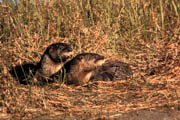River Otters Frolic
Through the Day
By Kathy Reshetiloff
If you've had the blues
lately or just need an attitude adjustment, you might want to
try to track down a river otter. Watching these playful animals,
whether outdoors or in a zoo, you can't help but begin to feel
the joy they seem to have for life. Everything they do looks like
a game. And as Marty Stouffer of "Wild America" once said, "If
it isn't fun, an otter just won't do it."
 The
river otter (Lutra canadensis) is actually in the weasel
family, a group of mammals known as mustelids which also includes
badgers, skunks and mink. Many mustelid mammals are very elusive
and rarely seen. River otters, however, are active and playful
by day, and, if not disturbed by people, are often seen playing
in small family groups. The river otter has many weasel-like features
including a long, sleek, muscular body, long flattened tail, short
legs and webbed feet. Otters are the largest of Maryland's fur-bearers
and vary in length from three feet to nearly five feet, head to
tail. They can weigh from 12 to 35 pounds. The
river otter (Lutra canadensis) is actually in the weasel
family, a group of mammals known as mustelids which also includes
badgers, skunks and mink. Many mustelid mammals are very elusive
and rarely seen. River otters, however, are active and playful
by day, and, if not disturbed by people, are often seen playing
in small family groups. The river otter has many weasel-like features
including a long, sleek, muscular body, long flattened tail, short
legs and webbed feet. Otters are the largest of Maryland's fur-bearers
and vary in length from three feet to nearly five feet, head to
tail. They can weigh from 12 to 35 pounds.
The river otter has dark brown fur, with a paler underbelly and
grayish throat. Small, close-set eyes near the top of the head
allow them to see when the rest of its body is submerged. Ears
are small and rounded and, like their nostrils, have valves to
shut out water. Prominent, white-tinged whiskers allow the otter
to sense prey in the water. The otter's long rudder-like tail
is thick at the base and tapers to a point. Feet are webbed. An
oily coat and a layer of fat allow the otter to tolerate icy water
temperatures.
In North America, river otters can be found in most of Alaska
and Canada, along the East Coast south to Florida, and west to
northern Utah. They are also found along the West Coast through
most of California.
Prior to the 1800s, otters were found throughout Maryland but
were extirpated from Garrett and Allegany counties and western
Washington County. In the early 1990s, the Maryland Department
of Natural Resources reintroduced the species to the region. As
a result, river otters are now distributed statewide. The highest
populations occur in the coastal plain close to the Chesapeake
Bay and decrease as one moves west in the state.
Like mink, river otters are semi-aquatic and are comfortable on
land and in the water. You'll find them in and around healthy
bodies of water including rivers, wooded streamside (riparian)
areas and tidal marshes. It's no wonder that fish make up most
of their diet, but they also feed on crustaceans, mollusks, amphibians,
reptiles and other small animals.
Well-adapted to life in the water, river otters swim rapidly on
the surface or underwater moving either forward or backward. They
can remain submerged for several minutes, swim up to a quarter
mile underwater, and dive to 55 feet. Due to their aquatic skills,
the otter has few natural predators. Young otters may be taken
by foxes or raptors, but most otter mortality, when not due to
natural causes, is caused by human activities.
River otters are just as comfortable on land. They can run as
fast as 15 to l8 m.p.h. If you get an opportunity to see an otter
on land, chances are it will be frolicking. Otters love to run
and slide, gliding as much as 25 feet on ice or mud and tumbling
into a snowdrift or splashing into the water.
Mud, ice or snow slides are the best known evidences of otters.
Haul-outs are other clues. These are trails coming out of the
water that contain parts of shellfish and droppings. Also, look
for otter trails which are about eight inches wide and may show
only heel pad and claws. An otter track shows its toes fanned
widely but doesn't show its webbing.
This endearing animal seems to love everything it does, whether
playing with a pebble, belly-sliding in the snow or hunting fish.
We can learn a lesson from watching them as they frolic through
life, and that is to try and find joy in all that we do.
 After
10 years as a biologist, Kathy Reshetiloff now writes on
a variety of topics for the U.S. Fish and Wildlife Service,
U.S. Department of the Interior. After
10 years as a biologist, Kathy Reshetiloff now writes on
a variety of topics for the U.S. Fish and Wildlife Service,
U.S. Department of the Interior.
|
Back
|

